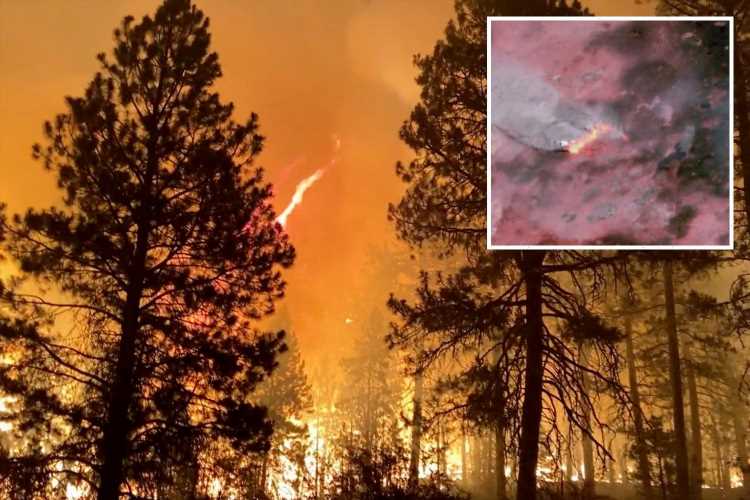EXPERTS have warned of fire tornadoes as the intense Bootleg wildfire continues to ravage parts of Oregon.
Scientists say the large inferno, which has destroyed more than 300,000 acres, is changing weather patterns.
The wildfire is affecting winds and disrupting the atmosphere, the New York Times reports.
Marcus Kauffman, of Oregon’s forestry department, said: “The fire is so large and generating so much energy and extreme heat that it’s changing the weather.
“Normally the weather predicts what the fire will do. In this case, the fire is predicting what the weather will do.”
The extreme heat and intensity of the flames can force wind to go around it, creating swirling clouds of heat known as “fire tornadoes”.
Meteorologist Chuck Redman told the Times that it’s “possible” a fire tornado may develop but the NWS has not received any reports.
He said: “When we get these extreme events, it’s stuff we’ve got to watch out for.”
'EXTREME HEAT'
The unpredictable winds have also caused the inferno to light rows of trees and ignite “spot fires” in random locations.
Scientists are also worried about lightning strikes as a mixture of smoke, hot air and water can create towering clouds, leading to thunderstorms.
Lightning strikes can create additional blazes, stretching the resources of fire crews.
The stark warning comes as the blaze has already burned through an area larger than the city of Los Angeles.
The blaze erupted on July 6 and more than 2,000 firefighters have been trying to keep the flames under control.
The Bootleg Fire is burning about 300 miles from the state's largest city, Portland, in and around the Fremont-Winema National Forest.
At least 160 homes and buildings have been destroyed as residents have been told to evacuate.
James Johnston, a researcher with Oregon State University's College of Forestry, warned the blaze could've caused more damage if it wasn't burning in such a remote area.
He said: "If the fire were in densely populated parts of California, it would have destroyed thousands of homes by now.
"But it is burning in one of the more remote areas of the lower 48 states. It's not the Bay Area out there."
If the fire were in densely populated parts of California, it would've destroyed thousands of homes by now."
Satellite footage captured by the National Oceanic and Atmospheric Administration shows the fire burning from space as smoke migrated.
Wildfires have ravaged parts of the southwestern United States as the West Coast is trapped under a heatwave.
Raging infernos gutted homes and cars in Doyle, California earlier this month as a devastating blaze was pushed along by heavy gusts.
Scientists have warned that the persistently high temperatures could lead to a "megadrought", which has the potential to unleash a climate catastrophe along the West Coast.
Water levels in the Great Salt Lake, Utah are almost at a record 58-year low and they are nine feet lower than average, according to the Daily Star.
'CLIMATE CATASTROPHE'
The vast lake doesn’t usually hit lows until October.
Arsenic could be picked up by the wind as soils dry out, creating a potential dust storm.
Over 16 million people already faced triple-digit temperatures during the last three heat waves that rampaged the region.
The western US baked as Las Vegas hit a record of 117 degrees – barely two weeks after a 1000-year heat event brought record highs of 116 and 121F in Portland and Lytton, Canada.
Scientists believe the 1000-year heat event that has the Northwest would have been "virtually impossible" without human-caused climate change.
In Seattle, temperatures are expected to top at 100 degrees for the 15th time this year, putting it on par to reach the city's record of 21 100-degree days in a year.
The National Weather Service confirmed that it’s the first time Washington state has been in “exceptional drought” since meteorologists launched the Drought Monitor in 2000, according to CNN.
Last month was the hottest June on record as eight states recorded new highs of well over 100F – shattering long-standing temperature records.
During the week of June 25, temperatures hit a sizzling 40 degrees above average, setting 175 record high numbers around the Northwest.
Source: Read Full Article










